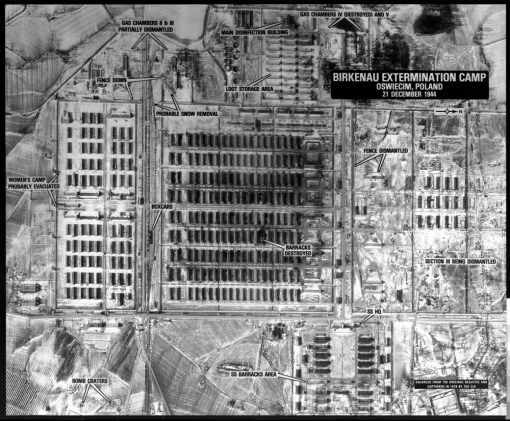
Electrified barbed wire fence and wooden barracks in Auschwitz II - Birkenau. These barracks were designed as prefabricated horse stables originally made for use on the eastern Front, against the Soviet Union. The wooden bunks, or “hutches” as they are sometimes called, contained as many as six prisoners on each shelf. Originally intended to house 250 prisoners, these barracks sometimes contained as many as a thousand. Photo: Quintin Lake

Barbed wire perimeter fence with brick chimneys belonging to ruined wooden barracks behind. Auschwitz II-Birkenau Extermination Camp (Poland). Photo: Quintin Lake

Aerial view of Auschwitz II - Birkenau. Photograph captioned by the Central Intelligence Agency December 21, 1944. Source: mazal.org
Birkenau was the largest of the more than 40 camps and sub-camps that made up the Auschwitz complex. The Birkenau camp is huge, covering 425 acres. The boundaries of Birkenau stretch a mile in one direction and a mile and a half in the other direction. During its three years of operation, it had a range of functions. When construction began in October 1941, it was supposed to be a camp for 125 thousand prisoners of war. It opened as a branch of Auschwitz in March 1942, and served at the same time as a center for the extermination of the Jews. In its final phase, from 1944, it also became a place where prisoners were concentrated before being transferred to labor in German industry in the depths of the Third Reich.
The majority—probably about 90%—of the victims of Auschwitz Concentration Camp died in Birkenau. This means approximately a million people. The majority, more than nine out of every ten, were Jews. A large proportion of the more than 70 thousand Poles who died or were killed in the Auschwitz complex perished in Birkenau. So did approximately 20 thousand Gypsies, in addition to Soviet POWs and prisoners of other nationalities. Source Auschwitz-Birkenau State Museum link



[…] Contact Quintin Lake Photography Blog Adventures in Architectural and Fine Art Photography « Photos: Auschwitz II-Birkenau Extermination Camp […]
[…] See also Jewish Museum, Berlin by Daniel Libeskind and Auschwitz-Birkenau Extermination Camp, Poland […]